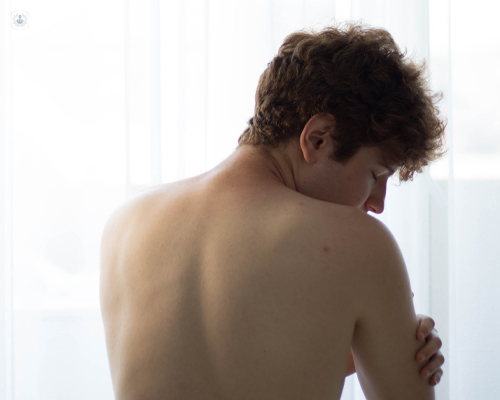Hydrodistension injection for frozen shoulder
Written by:Frozen shoulder is when your shoulder is stiff and in pain for months, or even for years in some cases. Hydrodistension is a treatment that a radiologist can perform to alleviate it. Dr Alistair Jepson is a highly regarded orthopaedic surgeon, specialising in shoulders. He explains this procedure and everything you need to know about before, during, and after.

What is hydrodistension?
Hydrodistension (also called hydrodilatation) is a particular kind of injection used to improve the movement of the shoulder joint and decrease pain in the shoulder. First the the capsule of the joint is stretched, and then the inflammation within it is reduced by injecting a mixture of sterile saline, local anaesthetic, and steroid. A specially trained doctor, known as a radiologist, uses x-ray or ultrasound guidance to ensure the injection is accurately placed in the shoulder joint.
What do I need to do before the appointment?
There are no specific requirements before this procedure, which is typically performed as outpatient. It is a good idea to organise for someone to drive you home afterwards (for insurance reasons). You may eat and drink as usual, unlike some other procedures. If you have specific allergies or are on any blood thinning medications, you should inform the office performing the hydrodistension in advance.
What can I expect to feel during this procedure?
Before the procedure, a local anaesthesia will be used to numb the skin and deep tissues. The numbing injection will feel like a sharp scratch. There should be very little feeling once the area is numb, other than the sensation of pushing and pressure while the procedure is taking place. If there is any pain felt, it will be brief. It has sometimes been described as a fullness or heaviness as the joint is filled with the solution. From start to finish it takes around 15 minutes.
What are the benefits and risks of hyrdodistension?
Both the reduction of pain in your shoulder and increase in movements are the benefits of the procedure – they are usually seen within a matter of days.
There are minimal risks with this procedure.
• Infection: a sterile technique is used when the needle is placed in the joint, minimising the risk. However, if your shoulder becomes swollen, painful and reddened following the procedure, or you feel unwell and feverish, then you should go to the nearest hospital Emergency Department to check that you have not developed an infection.
• Bleeding: inform the office and attendants if you are taking any blood thinning medications such as Warfarin, Dabigatran, Apixaban, Rivaroxaban, Enoxaparin or Dalteparin.
• If you are diabetic: you should carefully monitor blood sugars for the first 48 hours after the procedure, as blood sugar levels and insulin requirements may rise due to the steroid injection.
• Allergic reaction: an allergic reaction to the steroid or iodine contrast may happen but is very rare.
• Failure to improve symptoms: if the procedure does not work, discuss other alternatives with your doctor, like breaking the adhesions or scar tissue under general anaesthetic.
What happens after the procedure?
Some people have moderate discomfort that can last for 30 minutes afterwards. There may be bruising around the location of the injection, and the numbness of the skin will last for several hours. There may also be swelling and discomfort in the shoulder area. Usually, these side effects disappear after 48 hours. If necessary, usual painkillers can be taken to help. Most people feel fully back to normal after 24 hours and are usually back to typical daily activities (ie. work) the next day. General advice is that you do not drive or operate heavy machinery for the rest of the day following the procedure.
Physiotherapy should be resumed as soon as possible (ideally within two to three days after the procedure) in order to maximise the benefits gained during the procedure.
Will it work?
There is a nationally reported success rate of over 90 per cent in enhancing pain and over 70 per cent in enhancing the movement from the injection. If performed early in the disease process, it may decrease the natural condition resolution time. Sometimes there may be immediate relief, but for other people it may be several weeks before full benefits are achieved. To be stressed, accompanied physiotherapy following the procedure is important to see the improvements. The procedure can be repeated if the symptoms return or if it is only somewhat effective.
What if it does not work?
Discuss with your doctor about either repeating hydrodistension or possibly a keyhole surgical release (arthroscopic capsular release) combined with Manipulation Under Anaesthetic (MUA).
What follow-up is required?
It is recommended to see your physiotherapist three to four days after the procedure and your doctor between three and six weeks following the procedure.
If you are experiencing frozen shoulder and would like to schedule a consultation, you may head to Mr Jepson's Top Doctors profile.


